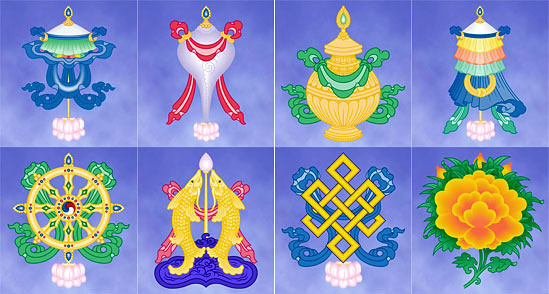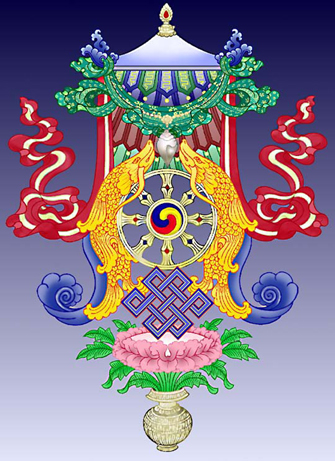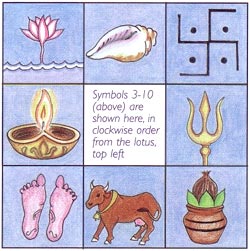 | ANKUSA (ANKUSHA): The goad (hook) held in Lord Ganesha's right hand, is used to remove obstacles from dharma's path. It is the force by which all wrongful things are repelled from us, the sharp prod which spurs the dullards onward. The ankusa is a hook-like instrument used as a goad to ride an elephant. It symbolizes discrimination, which can pierce through delusions. It is said that Vinayagar removes obstacles and troubles in our path using the ankusa. He helps us be rid of delusions. In Buddhism, it is considered a hook with which one can draw people in doubt to the teachings.
|
 | AUM (OM / PRANAVA): The root mantra and soundless sound from which all creation issues forth. It is associated with Lord Ganesha. Its three- syllables stand at the beginning and end of every sacred verse and every human act.
|
 | BILVA: The bael tree. Its fruit, flowers and leaves are all sacred to Siva, liberation's summit. Planting Aegle marmelos trees around home or temple is sanctifying, as is worshiping a Linga with bilva leaves and water.
|
 | BRAHMAN BULL: One of India's favorite sacred animals. It is depicted on the official state seal and is considered a symbol of happiness and strength.
|
 | CHAKRA: Means "wheel", is the circle of time, symbol of perfect creation, of the cycles of existence. Time and space are interwoven, and eight spokes mark the directions, each ruled by a Deity and having a unique quality.
|
 | CHANDRA-SURYA: Chandra is the moon, ruler of the watery realms and of emotion, testing place of migrating souls. Surya is the sun, ruler of intellect, source of truth. One is pingala and lights the day; the other is ida and lights the night.
|
 | DHARMA (DHARMACHAKRA): Buddhist emblem of Hindu origin. It resembles a wagon wheel with eight spokes, each representing one of the eight tenets of Buddhist belief. The circle symbolizes the completeness of the Dharma, the spokes represent the eightfold path leading to enlightenment.
|
 | DHAVJA: The orange or red banner (flag) flown above temples, at festivals and in processions. It is a symbol of victory, signal to all "Sanatana Dharma shall prevail". Its bold color betokens sun's life giving glow.
|
 | DIYA: A popular type of candle used during Diwali the "Festival of Lights".
|
 | GAJA: The elephant, king of beasts and sign of royalty and power He is Indra's mount, denoting the dominion of Heaven's King. In large Hindu temples and elaborate festive pageantry there is always a noble elephant.
|
 | GHANTA: The bell used in ritual puja, which engages all senses, including hearing. Its ringing summons the Gods, stimulates the inner ear and reminds us that, like sound, the world may be perceived but not possessed.
|
 | GO: The cow, is a symbol of the earth, the nourisher, the ever-giving, undemanding provider. She is symbolic of abundance, of the sanctity of all life and of the earth that gives much while asking nothing in return. To the Hindu, all animals are sacred, and they acknowledge this reverence of life in their special affection for the gentle cow. Indian scriptures tell us that the cow is a gift of the gods to the human race.
|
 | GOPURA: The towering stone gateways through which pilgrims enter the South Indian temple. Richly ornamented with myriad sculptures of the divine pantheon, their tiers symbolize the, several planes of existence.
|

| HAMAKUNDA (HOMAKUNDA): The fire alter, is the symbol of ancient Vedic rites. It is through the fire element denoting divine consciousness, that we make offerings to the Gods. Hindu sacraments are solemnized before the fire.
|
| | HAMSA HAND: In India, the hamsa is intended to ward off evil, specifically the evil eye, by deflecting the malign force downward into the earth, as a lightning rod diverts electricty. According to one tradition, the five fingers of the hamsa represent our five limbs, arms, legs, and head, the power of the enlightened being.
|
 | HAMSA SWAN: Vehicle of Brahma, is the swan (more accurately, the wild goose Aser indicus). It is a noble symbol for the soul, Paramahamsa, winging high above the mundane and diving straight to the goal.
|
| | HOLY ASH (BHASMA / VIBUTI): The three bands one could see on the foreheads of the gods and goddesses. This three bands are worn by the Shaivites and the other religions in that family (shakta, kaumara, ganapatya). As the God appeared as a Supreme Flame, in the Shaivite religion, (refer to lingam) Ash becomes the symbol that indicates the association with that param jyoti (Supreme flame).
|
 | JAGANNATHA (JAGANNATH): Means "Lord of the World" in Sanskrit, The name by which the Hindu god Krishna is worshiped at Puri, Orissa, and at Ballabhpur, West Bengal. The 12th-century temple of Jagannath in Puri towers above the town. The temple houses the rough-hewn wooden idols that represent Jagannath, his brother Balabhadra (also known as Balarama), and his sister.
|
 | KALASHA (KALESH): A husked coconut circled by five mango leaves on a pot, is used in puja to represent any God, especially Lord Ganesha. Breaking a coconut before His shrine is the ego's shattering to reveal the sweet fruit inside.
|
 | KALACHAKRA: Means "wheel, or circle, of time," is the symbol of perfect creation, of the cycles of existence. Time and space are interwoven, and eight spokes mark the directions, each ruled by a Deity and having a unique quality.
|
 | KAMANDALU: The water vessel, is carried by the Hindu monastic. It symbolizes his simple, self-contained life, his freedom from worldly needs, his constant sadhana and tapas, and his oath to seek God everywhere.
|
 | KONRAI: Golden Shower, blossoms are the flowering symbol of Shiva's honeyed grace in our life, Associated with His shrines and temples throughout India, the Cassia fistula is landed in numberless Tirumurai hymns.
|
 | KUTTUVILAKU: The standing oil lamp, symbolizes the dispelling of ignorance and awakening of the divine light within us. Its soft glow illumines the temple or shrine room, keeping the atmosphere pure and serene.
|
 | LINGAM: The prime symbol of worship for Shaivites. (In fact the name itself means symbol). This is broad in the middle and conical towards the top. This is the form of flame. In Shaivite philosophy the God is formless. Due to the Grace on the souls for the easy comprehension of the Divine and liberation the God appeared in the form of a Flame. This flame is what is worshiped as lingam in stone and other forms that make the worship easier. This is considered more sacrad than form worship by Shaivites.
|
 | MAHAKALA: Means "Great Time", presides above creation's golden arch. Devouring instants and eons, with a ferocious face, He is Time beyond time, reminder of this world's transfigurement, that sin and suffering will pass.
|
 | MANDALA: A circular, mystic diagram without beginning or end which indicates the higher and the lower and other possibilities; upon which one meditates. A tapestry, picture or grouping of words used in meditation to enter the realms depicted.
|
 | MANKOLAM: The pleasing paisley design, is modeled after a mango and associated with Lord Ganesha. Mangos are the sweetest of fruits, symbolizing auspiciousness and the happy fulfillment of legitimate worldly desires.
|
 | MALA: A strand of beads for holy recitation, japa, usually made of rudraksha, tulasi, sandalwood or crystal. Also a flower garland.
|
 | MAYURA (MAYIL): Or "peacock" is lord Murugan's mount, swift beautiful like Kartikeya Himself. The proud display of dancing peacock symbolizes religion in full, unfolded glory. His shrill cry warns of approaching harm.
|
 | MODAKA: A round, lemon-sized sweet made of rice, coconut, sugar and spices, is a favorite treat of Ganesha. Esoterically, it corresponds to siddhi (attainment or fulfillment), the gladdening contentment of pure joy.
|
 | MUDRA: Hand gestures employed in sacred dance and puja to focus the mind on abstract matters and to charge the body with spiritual power. This is chinmudra, the gesture of realization, reflection and silent teaching and comes from the Buddhist influence.
|
 | MUSHIKA: Our Lord Ganesha's mount, the mouse, traditionally associated with abundance in family life. Under cover of darkness, seldom visible yet always at work, Mushika is like God's unseen grace in our lives.
|
 | NAGA: The cobra, is a symbol of kundalini power, cosmic energy coiled and slumbering within man. It inspires seekers to overcome misdeeds and suffering by lifting the serpent power up the spine into God-Realization.
|
 | NANDI: The Lord Shiva's mount, or vahana. This huge white bull with a black tail, whose name means "joyful" is disciplined animalism kneeling at Shiva's feet , the ideal devotee, the pure joy and strength of Saiva Dharma.
|
 | NATRAJA (NATARAJA): The Lord Shiva as "King of Dance". Carved in stone or caste in bronze. His ananda tandava, the fierce ballet of bliss, dances the cosmos into and out of existence within the fiery arch of flames which denote consciousness.
|
 | PADMA (LOTUS): The lotus flower, Nelumbo nucifera, perfection of beauty, associated with Deities and the chakras, especially the I ,000 petalled sahasrara. Rooted in the mud, its blossom is a promise of purity and enfoldment.
|
 | PASHA: A tether or noose, represents the soul's three-fold bondage of anava, karma and maya. Pasha is the all-important force or fetter by which God (Pati, envisioned as a cowherd) brings souls (pashu, or cows) along the path to truth.
|
 | RUDRAKSHA (RUDRAXA): The seeds, Eleocarpus ganitrus, are prized as the compassionate tears Lord Shiva shed for mankind's suffering. Shaivites wear malas of them always as a symbol of god's love, chanting symbol of God's love, chanting on each bead. Rudra + Axa translates to the eye of rudra.
|
 | SEVAL: The noble red rooster who heralds each dawn, calling all to awake and arise. He is a symbol of the imminence of imminence of spiritual enfoldment and wisdom. This fighting cock bravely crows from Lord Skanda's battle flag.
|
 | SHANKHA (SHANKA CHAKRA): The water-born conch, symbolizes the origin of existence, which evolves in spiraling spheres. In ancient days it signaled battle's victory. In the Lord's hands it is our protection inner from evil, sounding the sacred Nadi.
|
 | SHATKONA: A "six-pointed star", is two interlocking triangles; the upper stands for Shiva, purusha and fire, the lower for Shakti, prakriti and water Their union gives birth to Sanat Kumara, whose sacred number is six.
|
 | SHIKARA: The massive superstructure which above the cave-like sanctuaries of temples in India. It is a living model of Mount Meru, the center universe where the themselves reside.
|
 | SHRI GANESH (LORD GANESHA): The Lord of Obstacles and Ruler of Dharma. Seated upon His throne, He guides our karmas through creating and removing obstacles from our path. We seek his permission and blessings in every undertaking.
|
 | SHRI PADUKA (TIRUVADI): The sacred sandals worn by saints, sages and Satgurus, symbolize the preceptor's holy feet, which are the source of his grace. Prostrating before him, we humbly touch his feet for release from worldliness.
|
 | SHRI CHURNA: The vertical three lines (or at times single red line) that is worn by the Vaishnavites is called Shri Churna. The two outer lines will be in the white color and the middle one in the red. The red line is normally with kumkum or the red sand at the base of the tulsi plant.
|
 | SHIVLIGA (SIVALINGA / SHIVA LINGA): Is the an mark or symbol of God. This elliptical stone is a formless form betokening Parasiva. That which can never be described or portrayed. The pedestal called pitha, represents manifest Parashakti.
|
 | SWASTIKA: The symbol of fortune - literally "It is well". The right-angled arms of this ancient sun sign denote the indirect way that Divinity is apprehended: by intuition and not by intellect.
|
 | TILAKA: This is the dot most of the Hindus have at the eye-brow junction. This could be of sandal or red kumkum or a mix of both. This junction is one of the very significant chakra, called in spiritual terms AGYA chakra. This is a very sensitive point. So the tilaka is kept at this point.
|
 | TRIKONA: The triangle, is a symbol of God Siva which, like the Sivalinga, denotes His Absolute Being. It represents the element fire and portrays the process of spiritual ascent and liberation spoken of in scripture.
|
 | TRIPINDA (TRIPUNDRA, THIRD EYE): The Saivite's great mark, three stripes of white vibhuti on the brow. This holy ash signifies purity and the burning away of anava, karma and maya. The bindu, or dot, at the third eye quickens spiritual insight.
|
 | TRISHUL (TRISHULA): Shiva's trident, carried by Himalayan yogis, is the royal scepter of the Saiva Dharma. Its triple prongs betoken desire, action and wisdom; ida, pingala and sushumna; and the three gunas - sattva, rajas and tamas.
|
 | URDVAPUNDRA: Is the royal mark upon the forehead of Vaishnavities. Two white lines are Vishnu's footprint resting upon a lotus base, The red represents Lakshmi. Thus the Lord's lowest part is worshiped on our highest.
|
 | VAJRA (DORJE): The word for the ritual implement held in the lama's right hand has been translated as thunderbolt but also diamond. The Sanskrit word vajra means adamantine, that is, "diamond-like." Therefore, besides being able to dent any object and overwhelm with its incomparable brilliance, the vajra or dorje represents great durability -- a hardness plus an immutability that is practically eternal.
|
 | VATA: The Banyan tree, Ficus indicus symbolizes Hinduism, branches out in all directions draws from many spreads shade far and wide, yet stems from one great Shiva as Silent Sage sits it.
|
 | VEL: Lord Murugan's holy lance, is His protective power, our safeguard in adversity. It's tip Is wide, long and sharp, signifying incisive discrimination and spiritual knowledge, which must be broad, deep and penetrating.
|
 | YANTRA: The Tantric Symbol of Cosmic Unity. A visual symbol traditionally used in the East as a centering device for meditation.
|





















































No comments:
Post a Comment